Related Research Articles
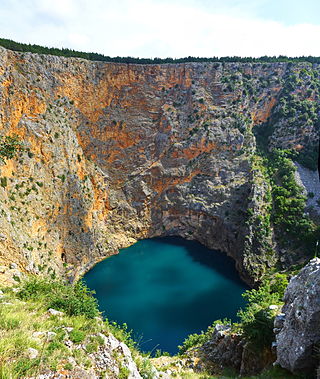
A sinkhole is a depression or hole in the ground caused by some form of collapse of the surface layer. The term is sometimes used to refer to doline, enclosed depressions that are locally also known as vrtače and shakeholes, and to openings where surface water enters into underground passages known as ponor, swallow hole or swallet. A cenote is a type of sinkhole that exposes groundwater underneath. Sink and stream sink are more general terms for sites that drain surface water, possibly by infiltration into sediment or crumbled rock.

Guilin is a prefecture-level city in the northeast of China's Guangxi Zhuang Autonomous Region. It is situated on the west bank of the Li River and borders Hunan to the north. Its name means "forest of sweet osmanthus", owing to the large number of fragrant sweet osmanthus trees located in the region. The city has long been renowned for its scenery of karst topography.
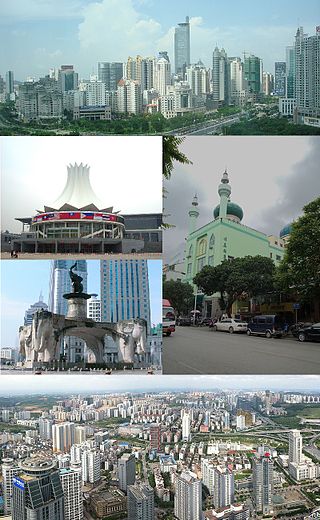
Nanning is the capital and largest city by population of the Guangxi Zhuang Autonomous Region in Southern China. It is known as the "Green City (绿城) " because of its abundance of lush subtropical foliage. Located in the South of Guangxi, Nanning is surrounded by a hilly basin, with a warm, monsoon-influenced humid subtropical climate.

Liuzhou is a prefecture-level city in north-central Guangxi Zhuang Autonomous Region, People's Republic of China. The prefecture's population was 3,967,900 in 2021, including 1,436,599 in the built-up area made of four urban districts. Its total area is 18,777 km2 (7,250 sq mi) and 667 km2 (258 sq mi) for the built up area.
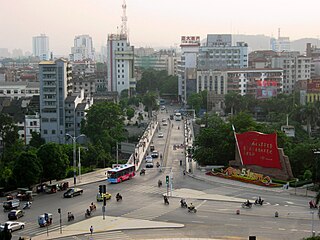
Baise, or Bose, is the westernmost prefecture-level city of Guangxi, China bordering Vietnam as well as the provinces of Guizhou and Yunnan. The city has a population of 4.3 million, of which 1.4 million live in the urban area.

Laibin is a prefecture-level city in the central part of the Guangxi Zhuang Autonomous Region, China.
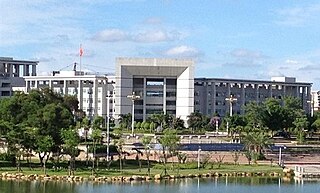
Chongzuo is a prefecture-level city in the south of Guangxi Zhuang Autonomous Region near the Sino-Vietnamese border. It is home to one of China's largest Zhuang populations.

A blue hole is a large marine cavern or sinkhole, which is open to the surface and has developed in a bank or island composed of a carbonate bedrock. Their existence was discovered in the late 20th century by fishermen and recreational divers. Blue holes typically contain tidally influenced water of fresh, marine, or mixed chemistry. They extend below sea level for most of their depth and may provide access to submerged cave passages. Well-known examples are the Dragon Hole and, in the Caribbean, the Great Blue Hole and Dean's Blue Hole.

Black Chasm Cavern is a cave in the hamlet of Volcano in Amador County, California.

Marvel Cave is a privately-owned cave located just west of Branson, Missouri, in Stone County. It is one of the main attractions of Silver Dollar City and is registered as a National Natural landmark.
William C. "Bill" Stone is an American engineer, caver and explorer, known for exploring deep caves, sometimes with autonomous underwater vehicles. He has participated in over 40 international expeditions and is president and CEO of Stone Aerospace.
Leye County is a county in the northwest of Guangxi Zhuang Autonomous Region, China. It is under the administration of Baise city.

Fengshan County is a county of Guangxi, China. It is under the administration of Hechi City.

Bamboo shoots or bamboo sprouts are the edible shoots of many bamboo species including Bambusa vulgaris and Phyllostachys edulis. They are used as vegetables in numerous Asian dishes and broths. They are sold in various processed shapes, and are available in fresh, dried, and canned versions.
Sanmenhai is a cave in the Leye-Fengshan geopark in Guangxi, China. The cave is unique in that it features seven skylights that mimic the layout of the constellation Ursa Major.
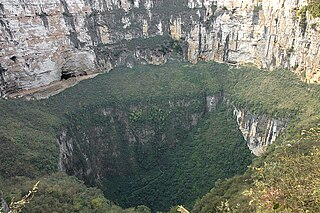
The Xiaozhai Tiankeng (小寨天坑), also known as the Xiaozhai Heavenly Pit, is the world's deepest sinkhole and also the largest in the Shaanxi cluster. It is located in Fengjie County of Chongqing Municipality in China.

Natural Trap Cave is a pit cave in the Bighorn Mountains, in northern Wyoming, United States. Excavations in the cave are an important source of paleontological information on the North American Late Pleistocene, due to a rich layer of fossils from animals that became trapped in the cave.
The 1973 Mount Gambier cave diving accident was a scuba diving incident in 1973 at a flooded sinkhole known as "The Shaft" near Mount Gambier in South Australia. The incident claimed the lives of four recreational scuba divers: siblings Stephen and Christine M. Millott, Gordon G. Roberts, and John H. Bockerman. The four divers explored beyond their own planned limits, without the use of a guideline, and subsequently became lost, eventually exhausting their breathing air and drowning. As of May 2015, they are the only known fatalities at the site. Four other divers from the same group survived.

Cave diving is underwater diving in water-filled caves. The equipment used varies depending on the circumstances, and ranges from breath hold to surface supplied, but almost all cave diving is done using scuba equipment, often in specialised configurations with redundancies such as sidemount or backmounted twinset. Recreational cave diving is generally considered to be a type of technical diving due to the lack of a free surface during large parts of the dive, and often involves planned decompression stops. A distinction is made by recreational diver training agencies between cave diving and cavern diving, where cavern diving is deemed to be diving in those parts of a cave where the exit to open water can be seen by natural light. An arbitrary distance limit to the open water surface may also be specified. Despite the risks, water-filled caves attract scuba divers, cavers, and speleologists due to their often unexplored nature, and present divers with a technical diving challenge.
References
- 1 2 3 Ming, Ye Charlotte (2022-07-08). "Descending Into the Lush Underworld of China's Newly Discovered Sinkhole". Atlas Obscura. Retrieved 2023-02-27.
- 1 2 Snider, Mike. "Giant sinkhole found in China has hidden forest with ancient trees growing at its floor". USA TODAY. Retrieved 2023-02-27.
- 1 2 3 Ink, Maria Bou (2022-10-15). "This Is What We Know About China's Massive Forest Sinkhole". TheTravel. Retrieved 2023-02-27.
- ↑ "Ancient Forest Found Inside A Giant Sinkhole In China". The Archaeologist. Retrieved 2023-02-27.
- ↑ "Southern China sinkhole discovered, home to towering ancient trees". FOX News. 2022-05-18. Retrieved 2023-02-27.
- ↑ "Gigantic forest discovered nestled in a sinkhole in China". MARCA. 2022-05-19. Retrieved 2023-02-27.
- ↑ Magazine, Smithsonian; Osborne, Margaret. "Ancient Forest Discovered in Chinese Sinkhole". Smithsonian Magazine. Retrieved 2023-02-27.
- ↑ "Chimonobambusa quadrangularis (Square Bamboo)". Bamboo Land. Retrieved 2023-02-27.
- ↑ "What we know so far about China's massive sinkholes". South China Morning Post. 2022-05-29. Retrieved 2023-02-27.